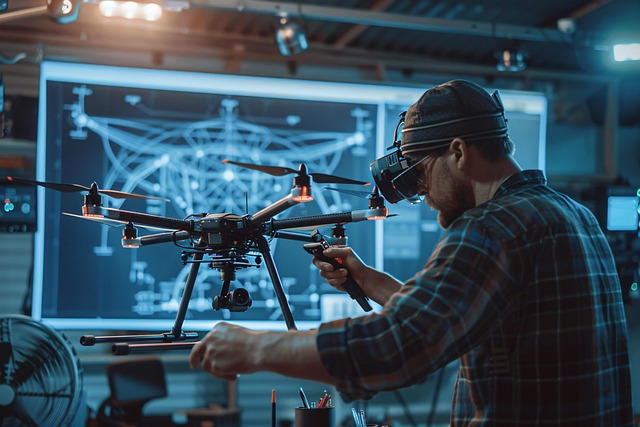Drone-based security systems have evolved from military and recreational uses to offer advanced real-time monitoring for commercial and civilian applications, leveraging high-tech sensors like high-resolution cameras, thermal imaging, LiDAR, autonomous flight, and intelligent algorithms. These drones capture detailed images, create 3D maps, detect anomalies, and transmit data instantly, enhancing security response times and enabling proactive monitoring. They provide superior visibility and accessibility in hard-to-reach areas, minimizing infrastructure needs, and offering cost-effective solutions for large or complex properties. Real-time data transmission to control centers aids swift action during threats or disasters, while continuous surveillance facilitates early detection of potential hazards, enhancing public safety. Urban surveillance and critical infrastructure protection are key areas where drone-based systems excel, but operators must navigate regulatory considerations such as no-fly zones, height restrictions, and data privacy regulations for effective implementation.
The integration of advanced drone technology into security monitoring has revolutionized real-time surveillance. This article explores the evolution and immense potential of drone-based security systems, highlighting their advantages in enhancing visibility and accessibility for immediate response. From urban environments to critical infrastructure protection, drones offer unprecedented capabilities. We delve into the benefits of real-time data transmission, navigate regulatory considerations, and discuss how these systems are shaping the future of security monitoring.
The Evolution of Drone Technology for Security Purposes
Drone technology has evolved significantly over the years, and its integration into security systems is a testament to this progress. Initially, drones were primarily used for recreational purposes or military operations, but advancements in automation, computer vision, and power management have led to their growing adoption in commercial and civilian applications. Today, drone-based security systems offer real-time monitoring capabilities, enhancing traditional security measures with aerial perspectives and advanced data collection.
These sophisticated drones are equipped with high-resolution cameras, thermal imaging sensors, and LiDAR technology, enabling them to capture detailed images and 3D mapping of secure areas. With autonomous flight capabilities and intelligent algorithms, drones can navigate complex landscapes, detect anomalies, and transmit data instantly. This enhances security response times and allows for proactive monitoring, making drone-based systems a game-changer in the field of real-time security surveillance.
Advantages of Drone-Based Security Systems: Enhanced Visibility and Accessibility
Drone-based security systems offer a significant advantage in terms of enhanced visibility and accessibility, revolutionizing real-time monitoring capabilities. With their high-resolution cameras and advanced sensors, drones can capture detailed images and data from hard-to-reach areas, providing a comprehensive aerial view that traditional surveillance methods struggle to match. This capability is particularly valuable for large or complex properties where ground-based security may have limited coverage.
Drones can swiftly navigate and cover vast areas, ensuring every angle is monitored. Their real-time video streaming capabilities allow security personnel to respond promptly to any incidents. Moreover, drone technology enables continuous monitoring without the need for extensive physical infrastructure, making it an efficient and cost-effective solution for enhancing security measures.
Real-Time Data Transmission and Its Impact on Immediate Response
Drone-based security systems have revolutionized real-time monitoring by enabling immediate data transmission to control centers. This capability is pivotal in scenarios demanding swift action, such as active threats or natural disasters. With live feeds transmitted directly from drones patrolling critical areas, security personnel can swiftly assess situations and deploy resources accordingly, leading to faster response times and potentially life-saving interventions.
The impact of real-time data transmission extends beyond immediate crisis management. It also enhances proactive security measures by providing continuous surveillance, allowing for early detection of potential hazards. This enables drone-based systems to serve as a robust early warning mechanism, giving authorities precious time to prepare and prevent escalating incidents, ultimately contributing to enhanced public safety.
Applications: From Urban Surveillance to Critical Infrastructure Protection
Drone-based security systems have a wide range of applications, from urban surveillance to critical infrastructure protection. In densely populated areas, drones can provide a bird’s-eye view of city centers, helping authorities monitor traffic flow, detect potential hazards like fires or leaks, and enhance public safety during large gatherings or natural disasters. By utilizing high-resolution cameras and thermal imaging technology, these unmanned aerial vehicles (UAVs) can offer real-time data that aids in quick response times and efficient crisis management.
Moreover, drone surveillance is invaluable for securing critical infrastructure such as power plants, dams, and communication towers. Drones can patrol hard-to-reach areas, detect unauthorized access or suspicious activities, and transmit alerts to security personnel. This proactive approach not only enhances the protection of vital assets but also contributes to maintaining national security by deterring potential threats before they escalate.
Navigating Regulatory Considerations for Effective Drone Surveillance Implementation
Implementing advanced drone surveillance for real-time security monitoring comes with a set of regulatory considerations that must be carefully navigated. As drone technology continues to evolve, so do the legal frameworks surrounding their use. In many jurisdictions, commercial drone operations require permits and certifications, especially when conducted in crowded urban areas or near sensitive infrastructure. Compliance with these regulations is not just about avoiding penalties; it ensures safe integration of drones into existing airspaces, protecting privacy rights, and fostering public trust.
Drone-based security systems offer immense potential for enhancing situational awareness and response times, but operators must stay informed about evolving laws and guidelines. This includes understanding no-fly zones, height restrictions, and data privacy regulations. Effective implementation involves ongoing monitoring of regulatory changes, proactive engagement with local aviation authorities, and ensuring that drone operations adhere to the highest standards of safety and ethical conduct.
Advanced drone surveillance represents a significant leap forward in real-time security monitoring, offering unprecedented levels of visibility and accessibility. The evolution of drone technology has empowered security professionals with a dynamic tool capable of swiftly gathering and transmitting critical data, facilitating immediate responses to threats. From urban surveillance to critical infrastructure protection, drone-based security systems are transforming the way we safeguard our communities. However, successful implementation requires careful navigation of regulatory considerations to ensure safety, privacy, and ethical deployment. Embracing these innovations while adhering to responsible practices is key to harnessing the full potential of drone surveillance for enhanced security.
